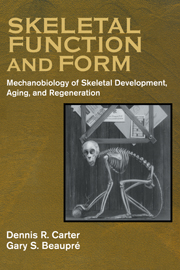Book contents
- Frontmatter
- Contents
- Preface
- Chapter 1 Form and Function
- Chapter 2 Skeletal Tissue Histomorphology and Mechanics
- Chapter 3 Cartilage Differentiation and Growth
- Chapter 4 Perichondral and Periosteal Ossification
- Chapter 5 Endochondral Growth and Ossification
- Chapter 6 Cancellous Bone
- Chapter 7 Skeletal Tissue Regeneration
- Chapter 8 Articular Cartilage Development and Destruction
- Chapter 9 Mechanobiology in Skeletal Evolution
- Chapter 10 The Physical Nature of Living Things
- Appendix A Material Characteristics
- Appendix B Structural Characteristics
- Appendix C Failure Characteristics
- Index
Chapter 10 - The Physical Nature of Living Things
Published online by Cambridge University Press: 11 January 2010
- Frontmatter
- Contents
- Preface
- Chapter 1 Form and Function
- Chapter 2 Skeletal Tissue Histomorphology and Mechanics
- Chapter 3 Cartilage Differentiation and Growth
- Chapter 4 Perichondral and Periosteal Ossification
- Chapter 5 Endochondral Growth and Ossification
- Chapter 6 Cancellous Bone
- Chapter 7 Skeletal Tissue Regeneration
- Chapter 8 Articular Cartilage Development and Destruction
- Chapter 9 Mechanobiology in Skeletal Evolution
- Chapter 10 The Physical Nature of Living Things
- Appendix A Material Characteristics
- Appendix B Structural Characteristics
- Appendix C Failure Characteristics
- Index
Summary
The preceding chapters provide an introduction to the role of physical factors in the development and evolution of the vertebrate skeleton. We have endeavored to present a coherent picture of the mechanobiological aspects of osteogenesis that encourages an integrated scientific approach to skeletal biology. The models and explanations offered in the text are intentionally simple, since the most direct models and explanations often provide the fundamental basis for understanding. Future refinements, extensions, and corrections by us and by others will surely follow.
Because our understanding of mechanobiology has progressed faster in the skeletal tissues than in other systems, this text has solely addressed the mechanobiology of skeletal development. However, skeletal tissues are not the only biological systems significantly impacted by mechanobiological principles. Other animal tissues and organ systems are also influenced in ways that may not be directly obvious. Currently, investigators are involved in studies on the role mechanical factors play in the development, adaptation, and aging of muscle and cardiovascular tissues. The application of mechanobiology in the study of plant development has also begun to provide a basis for understanding pattern formation throughout nature. It is safe to assume that virtually all cells and tissues respond biologically to mechanical influences to some degree. The tissues that perform a mechanical function or are exposed to significant forces seem to be the most significantly affected.
Current research in the life sciences is strongly based in cell and molecular biology. In these studies the chemical environment and response are a focus of intense interest, but insufficient attention has been given to the impact of physical factors.
- Type
- Chapter
- Information
- Skeletal Function and FormMechanobiology of Skeletal Development, Aging, and Regeneration, pp. 265 - 266Publisher: Cambridge University PressPrint publication year: 2000



